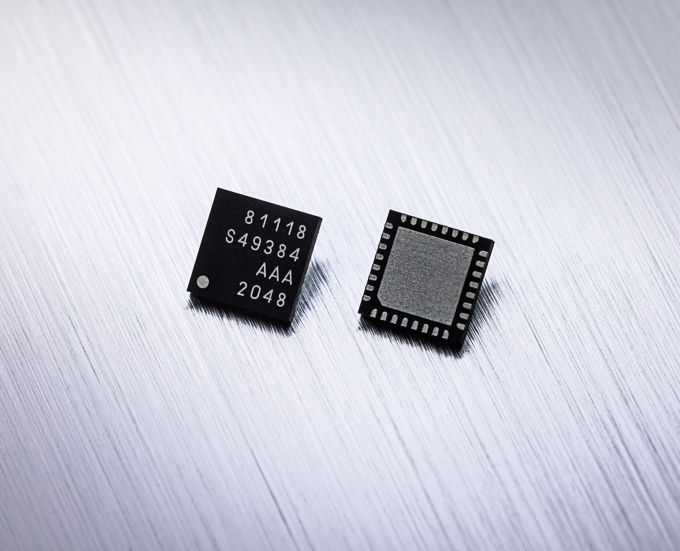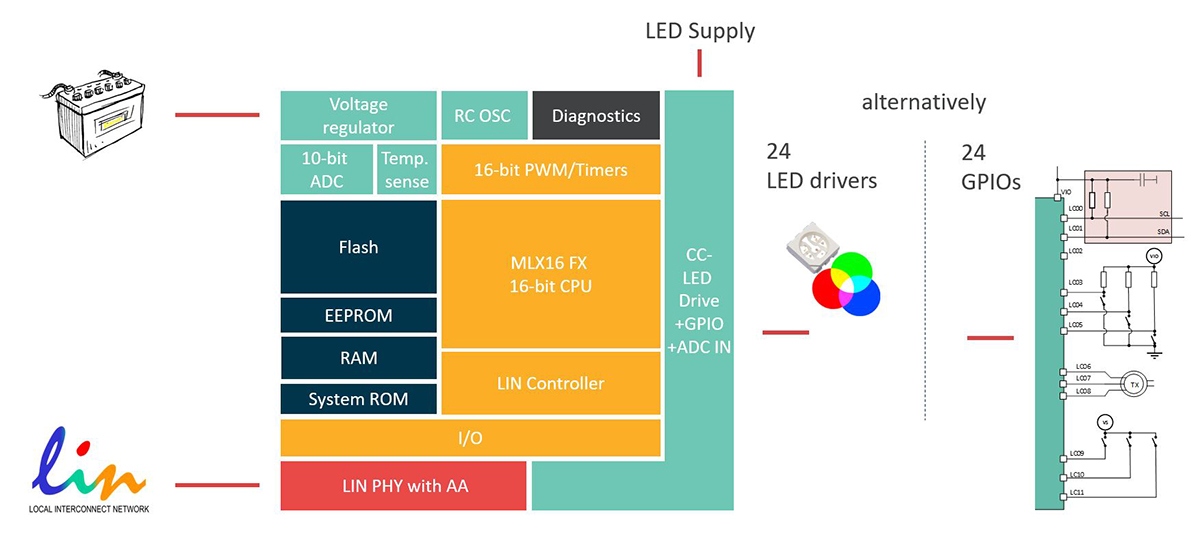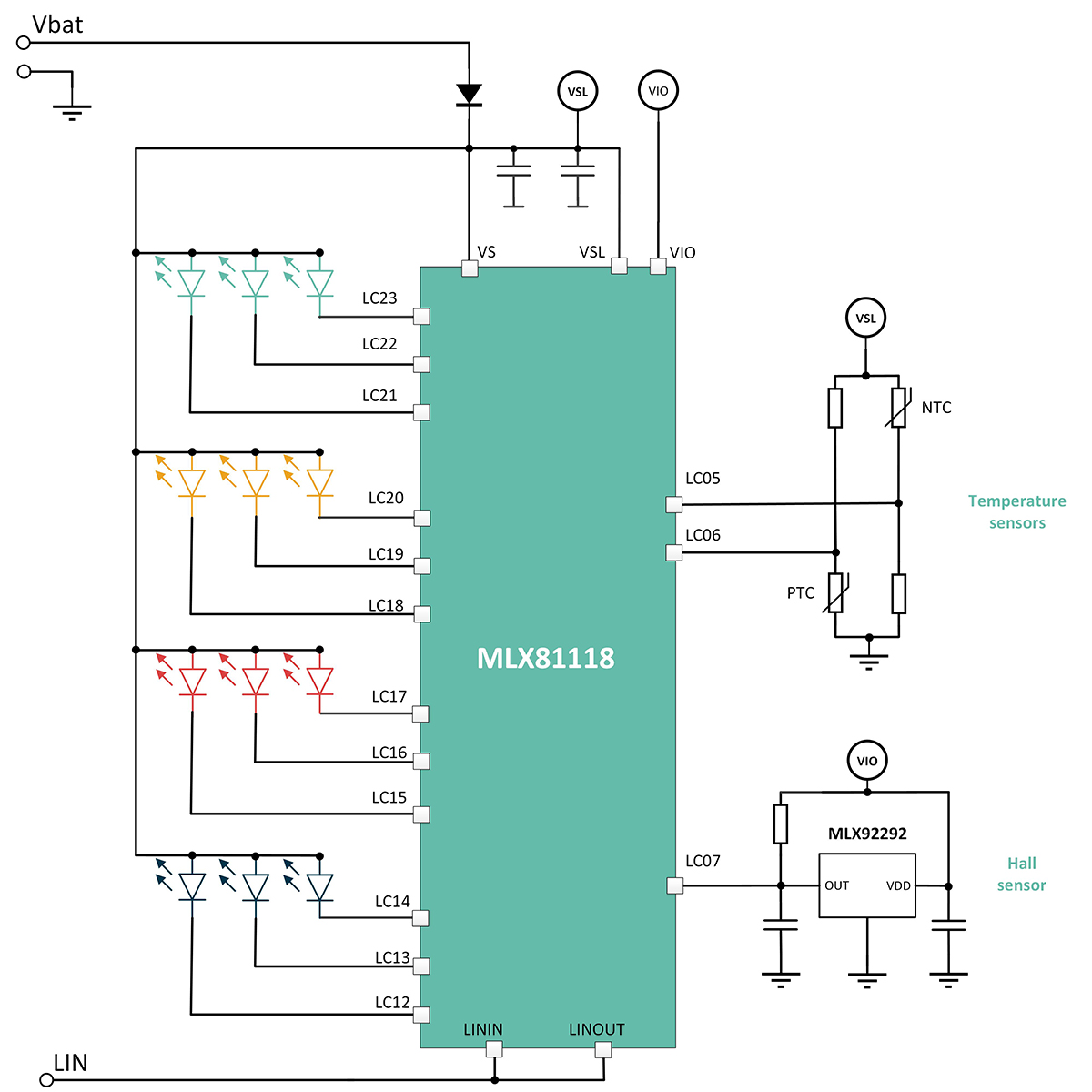利用智能控制和充电口盖监控,推进电动汽车充电接口设计的创新发展
作者:Andreas Laute、Raik Frost;迈来芯

图1:带有LED照明的电动汽车充电口
自汽车工业诞生一来,安全性始终是汽车设计的重中之重。与乘客直接互动的汽车系统,如气囊和安全带,对于确保乘客在车辆内的安全至关重要。但是,汽车安全系统的范畴远不止这些直接且显而易见的措施。仪表显示和仪表盘为驾驶员提供了有关车辆状态的关键信息,以及故障预警。
随着汽车行业全面转向电动汽车(EV),燃料来源和动力系统经历了彻底的革新和设计。这一变革催生了一系列新型车辆仪表需求,这些仪表不仅用于显示状态和安全警示,还对于保障驾驶员安全、提供充电状态及剩余续航等信息具有非常关键的作用。
因此,汽车制造商们现在正对几十年来基本保持不变的车辆系统进行重新设计。他们的目标是整合新功能,以确保功能性安全,并提升最终用户的驾驶体验,同时尽量减少电子系统复杂度潜在的增加。
从燃料加注口到充电口
对于以内燃机(ICE)为动力的汽车而言,燃料加注口一直是其固定且不可或缺的设计元素。由于汽车的燃料箱布局和重量分布要求,加注口在车辆上的位置往往是固定的,以满足实际运行需求。
对于电动汽车而言,其重量分布和设计限制与内燃机汽车大相径庭。此外,充电口与电池组之间的距离相对较远,相较于在燃料加注口和油箱之间简单的长燃料管道布置相比,这增加了系统设计的复杂性。
这一变革为设计师提供了更多的创造自由,使他们能够将充电接口重新安置在更加符合人体工程学的地方,如车辆的前端。这样的布局设计便于与停车位前端的电动汽车充电桩进行对接。
汽车设计的新元素
充电口在电动汽车的功能性中起着至关重要的作用。由于充电接口的使用频率极高,它们不仅需要具备高可靠性,还需要能够清晰地向驾驶者显示充电状态。为了满足这些需求,越来越多的汽车制造商开始在充电口区域安装LED灯(图1)。
这些灯光不仅用于指示充电状态,还能通过简单的光效变化来提示任何可能的故障状态。这样的设计使得在充电连接点就可以为用户提供明确且直观的指示,使他们能迅速了解电池电量或是否有任何安全风险。
动力总成的电气化显著增加了汽车设计的复杂性,从而对最新的充电口设计提出了额外的功能性要求。这包括监测充电口盖的开闭状态以及感知高压连接器的温度。
MLX81118搭载智能微控制器单元(MCU)和嵌入式快闪存储器,可实现灵活的系统设计与便捷的功能更新。其核心亮点在于作为高效的LED驱动器,该芯片能够提供每通道最高达60mA的可编程低侧电流源(支持最大1A LED电流),并通过精准的16位PWM调节(频率高达500 Hz)实现亮度控制。

Figure 2: Melexis MLX81118 LED driver IC
MLX81118集成了智能微控制器单元(MCU)和内置闪存,为系统设计提供极大的灵活性,并便于后续的功能更新。作为LED驱动芯片,其核心功能是为每个通道提供可编程的电流源,最高可达60mA,适用于低侧(最多可达1A LED电流)。通过16位的PWM(频率500 Hz)还能实现亮度控制。系统支持静态照明和基本动态LED光效。此外,MLX81118还能对每个LED进行诊断,并通过测量LED阈值电压来确定其温度(参见图3)。

图3:迈来芯MLX81118方框图及替代GPIO功能(来源:迈来芯)
该产品与现有产品的区别在于其多功能性。MLX81118提供24个通道,能够驱动RGB和/或单色LED,这一能力远超出了大多数专为充电接口设计的传统汽车LED驱动芯片。此外,这些通道还可以灵活配置为通用输入/输出(GPIO)通道。GPIO功能丰富多样,包括5V供电输出、20mA支持、SPI/I2C通信支持以及外部唤醒能力,还能够使用集成的模数转换器(ADC)配置GPIO。
这种卓越的灵活性使得该产品能够适用于更广泛的场景,并具备高级功能和本地控制能力,远远超越了传统LED驱动芯片的限制。
开发更智能的充电端口
在车辆内部,工程师可以利用迈来芯MLX81118的卓越灵活性来构建更智能化的充电口,而无需显著增加材料清单(BoM)中的组件数量。
在充电点安装中,该芯片集成的10位ADC可以轻松配置到GPIO,例如,用于测量充电口高压连接器之一或多个的传感器温度。在功能安全环境中,了解充电连接器的温度至关重要。此外,MLX81118驱动芯片还配备了内部温度传感器,以补充任何外部测量,并提供有关充电口环境温度的精确信息。
在此配置中,MLX81118可以精确监控外部温度传感器的信息,并将这些关键数据传递给车辆系统。例如,在检测到过温错误时,芯片的智能编程可以用于通过在附近点亮红色闪烁的LED来提醒驾驶员端口中的过热情况。同时,这些实时数据可以通过LIN接口或配置为SPI或I2C接口的GPIO通道输出回其他组件和控制器。
除了与温度相关的功能外,MLX81118的灵活性还可以帮助设计改进充电口安全性的其他方面以及最终用户的体验(图4)。

图4:迈来芯MLX81118充电口照明,带有温度传感器和充电口盖监控的示例电路(来源:迈来芯)
监测充电口盖开启或关闭状态的一种高效方法是结合使用霍尔或电感式开关。迈来芯的MLX92292(霍尔开关芯片)或MLX92442(Induxis®开关芯片)均为出色的选择。通过将霍尔传感器芯片的输出连接到MLX81118的GPIO,充电口盖的位置状态可以通过LED驱动芯片的LIN接口被车辆车身域控制器(BDC)实时监测。这种智能集成有助于减少与车辆BDC的连接数量,同时允许充电口盖位置的变化直接触发LED。
这种智能集成和充电口盖位置与LED驱动芯片之间的直接连接,为提升最终用户体验提供了丰富的可能性。例如,通过对MLX81118进行巧妙设置,可以实现在光线较暗的环境中,一旦充电口盖被打开,MLX92292传感器的状态变化会被检测到,随机引起电路的响应,激活周围的LED提供照明,从而确保驾驶员在夜间或低光条件下也能清晰地看到充电口的位置。同样,设计师可以选择加入额外的智能功能,比如当断开充电器后,如果充电口盖仍然保持打开状态,LED可以一种可辨识的方式闪烁,降低在行驶中损坏充电口的风险。另一个可能性是通过改变亮起LED的数量或颜色来反映充电状态。
与实施此类功能所需的传统方式相比,使用MLX81118,所有的逻辑和控制都在充电点组件上进行管理,减轻了中央或区域车辆控制系统的处理负担。
结论
汽车设计师一直在追寻能够实现本地化决策、执行安全关键任务,同时又不会显著增加组件数量或处理负荷的智能解决方案。LED作为汽车设计中不可或缺的一部分,不仅为车辆增添独特风采,还能向驾驶者传递关键信息。MLX81118应运而生,为电动汽车充电接口及其他LED应用场景提供了一种创新性解决方案。这一方案的灵活性不仅推动了汽车设计在其他领域的创新,而且有望为更广泛的市场带来变革和拓展。






